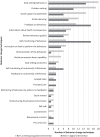Blended Care Interventions to Promote Physical Activity: A Systematic Review of Randomized Controlled Trials
- PMID: 35907158
- PMCID: PMC9339043
- DOI: 10.1186/s40798-022-00489-w
Blended Care Interventions to Promote Physical Activity: A Systematic Review of Randomized Controlled Trials
Abstract
Background: Blended care interventions combine therapeutic guidance with digital care. Current research results show the promising role of the blended care approach in clinical care. This new way of delivering health care could have the potential to effectively promote physical activity in different public health settings.
Objective: The aim of the systematic review is to investigate the varieties of intervention characteristics of blended care interventions to promote physical activity in terms of structure, behavior change goals, behavior change techniques, and effectiveness of blended care interventions compared to a control group.
Methods: We searched for randomized controlled trials published from 2000 to March 2021 in MEDLINE, CINAHL, Cochrane Central Register of Controlled Trials, SPORTDiscus, PsycINFO, and Web of Science according to the PRISMA guidelines. Risk of bias was assessed using the Cochrane Collaboration tool. Study characteristics, intervention characteristics, and outcome data were extracted. Furthermore, the effect size on the outcome of physical activity was examined or calculated.
Results: In total, the number of reports identified from the database searches was 4828. Of these, 25 studies were included in the review, with a total of 5923 study participants. Results indicated that the characteristics of blended care interventions showed a high heterogeneity. The combinations of therapist-guided interventions and digital interventions allowed the identification of specific subgroups, but they varied in length (range 8-52 weeks, SD 16.6), intensity, and the combination of the components. The most used combination of blended care interventions to promote physical activity was the combination of one-on-one meetings via telephone and Web-based interventions. Motivational models of behavior change were used most frequently as underlying theoretical foundations. Certain behavior change techniques were used consistently across the individual components, e.g., "problem solving" in the therapist-guided component and "feedback on behavior" in the digital component. Considering the effect size of blended care interventions compared with control groups, most studies showed a small effect.
Conclusions: It can be concluded that blended care interventions have potential to promote physical activity. In the future, further high-quality studies should investigate which type of blended care intervention is effective for which target group. Additionally, insights are required on which intervention characteristics are most effective, taking into account new evidence on behavior change. Registration This systematic literature review was registered in PROSPERO ( CRD42020188556 ).
Keywords: Behavior change; Blended care interventions; Digital intervention; Physical activity; Therapist-guided intervention.
© 2022. The Author(s).
Conflict of interest statement
Vivien Hohberg, Reinhard Fuchs, Markus Gerber, David Künzler, Sarah Paganini, and Oliver Faude do not have any competing interests with regard to the content of the present manuscript.
Figures




Similar articles
-
Behavioural modification interventions for medically unexplained symptoms in primary care: systematic reviews and economic evaluation.Health Technol Assess. 2020 Sep;24(46):1-490. doi: 10.3310/hta24460. Health Technol Assess. 2020. PMID: 32975190 Free PMC article.
-
Blended Interventions to Change Behavior in Patients With Chronic Somatic Disorders: Systematic Review.J Med Internet Res. 2017 Dec 21;19(12):e418. doi: 10.2196/jmir.8108. J Med Internet Res. 2017. PMID: 29269338 Free PMC article.
-
Behavioural interventions for type 2 diabetes: an evidence-based analysis.Ont Health Technol Assess Ser. 2009;9(21):1-45. Epub 2009 Oct 1. Ont Health Technol Assess Ser. 2009. PMID: 23074526 Free PMC article.
-
The future of Cochrane Neonatal.Early Hum Dev. 2020 Nov;150:105191. doi: 10.1016/j.earlhumdev.2020.105191. Epub 2020 Sep 12. Early Hum Dev. 2020. PMID: 33036834
-
Public sector reforms and their impact on the level of corruption: A systematic review.Campbell Syst Rev. 2021 May 24;17(2):e1173. doi: 10.1002/cl2.1173. eCollection 2021 Jun. Campbell Syst Rev. 2021. PMID: 37131927 Free PMC article. Review.
Cited by
-
Physical Activity Interventions Framed by the Health Action Process Approach for Adults with Long-Term Conditions: A Scoping Review.Int J Behav Med. 2024 Dec;31(6):987-1017. doi: 10.1007/s12529-024-10305-2. Epub 2024 Jul 15. Int J Behav Med. 2024. PMID: 39009797 Free PMC article.
-
Feasibility of an Application-Based Outpatient Rehabilitation Program for Stroke Survivors: Acceptability and Preliminary Results for Patient-Reported Outcomes.Bioengineering (Basel). 2024 Jan 29;11(2):135. doi: 10.3390/bioengineering11020135. Bioengineering (Basel). 2024. PMID: 38391621 Free PMC article.
-
Effective Behavior Change Techniques in Digital Health Interventions for the Prevention or Management of Noncommunicable Diseases: An Umbrella Review.Ann Behav Med. 2023 Sep 13;57(10):817-835. doi: 10.1093/abm/kaad041. Ann Behav Med. 2023. PMID: 37625030 Free PMC article.
-
Exploring perspectives on digital smoking cessation just-in-time adaptive interventions: A focus group study with adult smokers and smoking cessation professionals.PLOS Digit Health. 2025 May 2;4(5):e0000705. doi: 10.1371/journal.pdig.0000705. eCollection 2025 May. PLOS Digit Health. 2025. PMID: 40315200 Free PMC article.
-
Short-term outcomes of physical activity counseling in in-patients with Major Depressive Disorder: Results from the PACINPAT randomized controlled trial.Front Psychiatry. 2023 Jan 18;13:1045158. doi: 10.3389/fpsyt.2022.1045158. eCollection 2022. Front Psychiatry. 2023. PMID: 36741581 Free PMC article.
References
-
- World Health Organization . Global action plan on physical activity 2018–2030: more active people for a healthier world. Geneva: World Health Organization; 2019.
Publication types
Grants and funding
LinkOut - more resources
Full Text Sources

